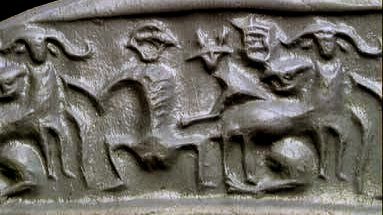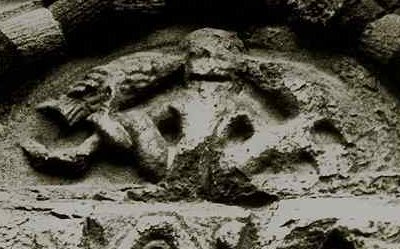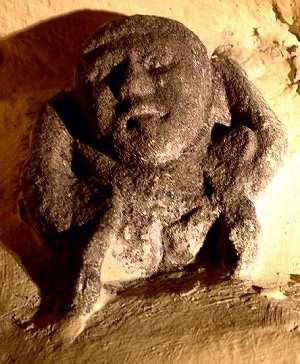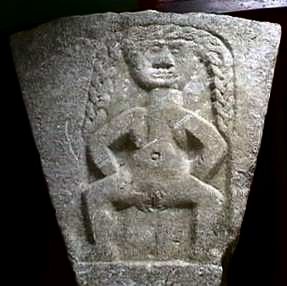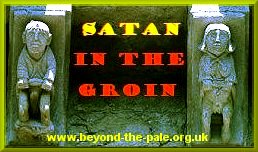the infernal consequences of illicit sex
SATAN IN THE GROIN
exhibitionist
carvings
on
mediæval churches
by
male
genital exhibitionists
on mediæval churches
beard-pullers
in the silent orgy
ireland
& the phallic continuum
field
guide
to megalithic ireland
the
earth-mother's
lamentation
beasts and monsters of the mediæval bestiaries
Map
of most figures in England,
Scotland and Wales
List
and distribution map
of Irish
genital exhibitionists
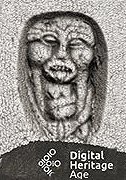
Small 'sheela-na-gig'
above a doorway
in Moate (Westmeath), Ireland.
She is wearing a band just below her breasts.
from The Seduction of Morality by Tom Murphy (1994) , one of a succession of novels and plays written since Irish independence about Irish poverty, economic and spiritual:
"She withdrew her arm and then took her hand upwards to stroke the curve of her belly, then downwards again, through the hair, turned the fingers in between her legs to find the it of the girl, the what, the quem, gee, the job, the word that offended her, the font, the nothing, the everything, the hole, to find it wet. Good. When fishes flew and forests walked and whatever the rest of it is."
["the rest of it" is contained in G.K. Chesterton's poem The Donkey. The underlining is mine and indicates the correct modern pronunciation and meaning of 'gig'.]
Anthony Weir
co-author of "Images of Lust"
From
Sermons
in Stone
to the Petrified Hag
female exhibitionist figures - part I
The Wealthy Man or Moneylender clutching
and weighed down by his scrotal moneybag
on the right-hand side of the church-doorway at Jazeneuil (Vienne),
France. click
to enlarge
In
turbulent, violent 12th century Europe
the two most dangerous and pernicious sins were considered by the pious
(especially in Western France, ravaged by Plantagenet princes at war
with each other,
and in Northern Spain, victim of a genocidal land-grab in the name of
Christ)
to be WEALTH
(Avaritia)
and the SPENDING of wealth on goods, services
and sensuality (Luxuria).
These were the two most tangible manifestations
of the overriding sins of PRIDE (Superbia)
and VAIN-GLORY
(Vanitas).
Nine hundred years later,
these most insidious sins, so widely condemned by both offical and heterodox
Christianity,
have ousted every god and virtue to become the two pillars of Capitalism,
the thronged portal of Mammon's New Jerusalem Mall.
Almost
no-one now believes that money is the devil's seed.
Especially not in fundamentalist America.
But the sin of avaritia was, especially from the 11th to the
14th centuries,
'the sin of Judas'.
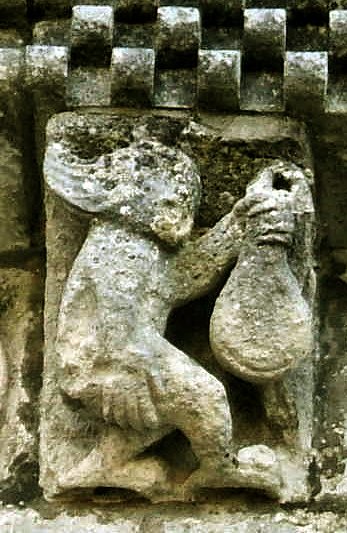
A 'moneybags' on the West front, Saint-Fort-sur-Gironde (Charente-Maritime)
AVARITIA TRIUMPHANT
The New Europe: 1200 to the present
|
The bloody, war-torn twelfth century was economic and artistic boom-time for Europe, despite the pillage of warring princes who devastated huge areas where rape, mass-murder and starvation stalked the land. At the same time the monastic movement underwent spectacular expansion, making the Romanesque the greatest art movement in history. A large part of the expanding wealth of the monasteries derived from their control in the 11th century of the main routes which criss-crossed Europe: the many Pilgrimage roads to Rome, Jerusalem and Santiago de Compostela. There was also the important factor of a century or two of (minor) global warming which allowed a great increase in general cultivation - and grape vines to flourish even in Ireland - before the "mini-Ice Age" arrived in the 14th century, bringing The Black Death in its train. The rise of the monasteries itself came with the great sigh of relief that Armageddon had not come on the year 1000 A.D. (though of course Homo sapiens is itself Armageddon extinguishing the rest of the natural world). This was followed by the emergence of the papacy from the internecine "Papal Dark Age" under Urban II, and his genocidal proclamation of the terrible First Crusade, which attracted all the most vicious and racist people in Western Europe, and set thrm on their way pillaging and burning all the way (via Constantinople) to a blood-bath in multi-cultural Jerusalem, followed by the establishment of (relatively tolerant) principalities in Palestine. The beginning of a nine-hundred-year war against (and, latterly, humiliation of) Islam, went with the promulgation of the celibacy of the clergy in the Western (Catholic) church, mainly to distinguish it from both the Eastern church and Islam. At a time when armies, and some individuals - including stonemasons - travelled huge distances by foot or horseback (Eleanor of Aquitaine covered thousands of miles every year with or without her second husband Henry II of England, Ireland and Anjou), the Pilgrimage to Santiago became the greatest 'tourist' industry until the late twentieth century. The pilgrimages to Compostela and Jerusalem (when there was no Crusade raging) were symbolic of the pilgrim's progress through life to the Eternal City. They were undertaken mainly to attain merit or to expiate sin: even eating fat meat during lent could be sufficient reason to go (or be directed to go) to Santiago as penitence. From Jerusalem and returning Crusaders came a fad famously known as Courtly (asexual) Love, which originated in Iran and was (there, in any case) largely homoerotic. Eleanor allegedly presided over certain courtly and poetic ceremonies in Poitiers, seat of her father, Duke Guillaume IX, 'the troubadour prince' of Poitou – one of the richest areas of Romanesque architecture and sculpture whose designs and motifs spread to the north of France, England, and even Ireland. It was in the 12th century also that court Fools were introduced to Europe. In our own times the autobahns of Germany have produced the Autobahnkirche (Catholic and Lutheran), open at all times to service the 'spiritual requirements' of fraught travellers. These pit-stops for the pious and frazzled are pale and sad imitations of the churches which lined the routes to Rome and, especially, Santiago. Catering for poor pedestrians as well as the rich on horseback or in carriages, they were, of course, far more frequent than the service-stops on modern motorways. This servicing of the Pilgrim Roads from the Baltic and the Hungarian Plain to Atlantic Spain brought – and distributed – riches throughout Europe: wealth and the means to move it unknown since Roman times. This wealth, of course, attracted all sorts of unwelcome (to the church) attachments, such as musicians, entertainers, jongleurs and whores, pedlars of all kinds, and people displaying deformities or strange animals. Even now, in France, the last survivors of a disgusting tradition of exhibiting doped piglets and kids in cages for children to stroke, attract no opprobrium from a population brought up to regard animals as stupid machines.
It also created many thousands of craftsmen, including stonemasons and sculptors. The latter could not have failed to observe that the richer people become, the meaner they generally get: to become rich you often have to be mean in all senses of the word. Where money was newest, during the land-grab of the Reconquista in Spain, it seems that the arriviste nouveaux-riches often cheated or short-changed those who built the churches that they endowed, for very many churches there show signs of incompletion, with scaffolding holes not filled in. But boom ensured the slow economic demise of the monasteries, due to the rise of the cities which used money, and the new monarchies which they serviced. The monasteries used almost no cash, the economy being largely one of deferred payment by goods, services, labour and agricultural produce. However, the economy that they stimulated was a cash economy based on import (mainly spices and other luxuries from the East) and export (such as wool and textiles from Yorkshire, Northern France and modern Belgium). The centres of power shifted from the great abbeys to towns which were centres of pilgrimage in themselves - Limoges, Tours, for example, and towns which were natural hubs of trade and intellect - Poitiers (with its mythical Courts of Love and six Romanesque churches), Toulouse, Paris, Laon, Bologna, Salamanca, Pisa, London and Oxford. The monastic dislike of money and resentment of the rising rich new towns with their luxuried class and their squalid underclass, fed into the iconography of sin, notably in depictions of Wealth (avaritia) - even on large urban churches such as Sainte-Croix in Bordeaux. A very fine example of a rich man or moneylender tortured by hellish monsters can be seen on an interior capital at Lucheux (Somme). (For more on monsters click here.) And how well-founded their fear of money turned out to be. Luxury largely depends on usury (moneylending). Because usury remained a criminal sin (forbidden also to Muslims), the lending economy (necessary for most enterprises beyond monastery lands) was initially forced upon the Jews, who were then reviled for this as well as for being 'Christ-killers'. The business quickly passed to professional bankers (mostly from Lombardy) - while the Church itself sold not just benefices to the second sons of counts, princes and merchants, but pardons and indulgences to the masses. This, of course, eventually formed the basis of anti-Christian capitalism - and sowed the seeds of the Reformation which encouraged it. Wealthy man or money-changer with moneybag, Rots (Calvados) As power slipped away from the Benedictines and Cistercians to the fat clergy of the new cathedrals based in in the burgeoning towns - and the powerful order of Dominicans who used their control of the Holy Inquisition as an instrument of terror, Europe descended into what we now think of as mediæval superstition, often (and still) obsessed with blood. All sorts of horrors erupted out of Christianity - notably the 'Blood Libel' invented by the clergy of Norwich cathedral in order to acquire a prestigious and lucrative boy-saint at the expense of the 'Christ-killers'. The Blood Libel - the cleverly-insane calumny that Jews used the blood of (usually crucified) boys to make Passover matsos - spread all over Europe. The last official case, in Kiev in 1911, was instigated by an extreme monarchist group and, despite nobbling of the judge and jury by the Tsarist authorities, the court set free the Jewish scapegoat who soon afterwards emigrated to America. In the United States today the Blood Libel is still promulgated by video, and latterly, of course, Arabs (notably the Defence Minister of Syria) have started to re-invigorate the story. The Crusades linked Christian 'spirituality' to violence and ethnocide: the church militant was born - and in no time created the Inquisition. (It took Islam nearly a thousand years to descend to the same level and attempt a payback.) With the decline of the non-urban monasteries and the accompanying rise of Gothic cathedrals centered in the cities, came a complete change in the art and the iconography echoing the change in outlook or Zeitgeist. The whole richly meaningful, and complex and sometimes earthy iconographic repertoire of the Romanesque became old-fashioned like the churches. The Romanesque was very firmly and sanely installed between Heaven and Hell, whereas the unhinged Gothic attempted to float to Heaven on its pinnacles and spires and Inquisitional unreason, despising the earthy, folksy, grounded qualities of the Romanesque. As a result, it served the illiterate badly, driving them to superstition. Towards the end of the twelfth century a crucial shift in the Western European (but not Eastern Orthodox) perspective on the crucifixion occurred. Whereas from early Roman Christian times Jesus was portrayed as standing triumphant (like a latter-day Apollo) on his cross, conquering death, by the 13th century Jesus was shown in gruesome suffering, hanging from the cross in agony. This might have had something to do with the rise of the mendicant orders, and of the new cult of the Blessed Virgin Mary introduced by St Bernard of Clairvaux and the Cistercians. The triumph over death's dark dominion was no longer due directly to the single event of the crucifixion, but, instead, to the agony and suffering of the crucifixion. Suffering in itself became meritorious, as Western Europe became richer - and more war-torn. Romanesque sculpture features remarkably few Biblical themes. Adam and Eve (almost always with their 'private parts' covered by hands or fig-leaf) are common on capitals; Daniel and the Lions a little less so, but in greater and marvellous variety. Occasionally there are Noah and his Ark, Tobias (carrying the huge fish) from the obscure book of Tobit, and, from the New Testament, Lazarus and his dog under the Rich Man's table. Most Romanesque sculpture is moralistic (e.g. the Psychomachia or War between the Virtues and Vices), or minatory: 'these things you may not do if you wish to escape damnation'. Many of the latter type occur on corbels, though in some places they were deemed important enough to be placed on doorways and interior capitals. Doorways very often illustrated also the punishment of sin in Hell, often symbolically as a person being swallowed by a lion or monster: the jaws of Hell. Illustrations of Luxuria almost always show the punishment thought to be meted out eternally to those living 'La Dolce Vita': snakes, toads or even tortoises forever suckling/biting their desiccated dugs, or entering/emerging from their vulvas. St Bernard famously protested (around 1125) about the fabulous monsters and other frippery which diverted the attention of the (illiterate) people from their imminent damnation. Indeed, he said, "there is seen everywhere such a arvellous diversity of forms that people read with greater pleasure what is carved in stone than what is written in books, and would rather gaze all day upon these singular creations than to meditate upon the Divine Word." Then he reveals himself as the mean cleric he was by adding: "O God! if one is not ashamed of the childishness of these carvings, why does not one spare the expense ?" And expensive they could be. The façade of Notre-Dame-La-Grande in Poitiers could not be carved today for less than tens of millions of pounds sterling.
One of the greatest banes of the Church in the Middle Ages was the Fairs - always drunken, riotous - often murderous - attended by conmen and pickpockets - hence the French expression : S'entendre comme larrons en foire (to be as thick as thieves at a fair). Figurative Romanesque corbels for the most part represented two groups of subjects: human heads, beasts and monsters; and images of sinners mostly on the margins of society, including entertainers: jongleurs, acrobats, tumblers, dancers. buffoons, performing animals, contortionists, mummers, ventriloquists, 'freaks', exhibitionists, 'musical' farters, and, of course, musicians. A visit to convincing re-creations of such entertainments by the group Daughters of Elvin on YouTube will suggest to some degree the alarm (if not horror) clerics and monks would have felt. The church, of course, wanted all entertainment to be under its control. It deplored the immorality 'depraved' street entertainers encouraged, as well as the paltry incomes that they received. Interestingly, it was in the 12th century that European kings and princes introduced Fools and Jesters into their courts: licensed tellers of truth to power right up to the 17th century. They then deteriorated into the harmless (but often frightening) circus clowns of the 19th century. The church had a concept of Divine Music – or music worthy of offering up in praise of the Christian Divinity. Occasionally there are depictions of David dancing before thee Ark of the Covenant, but more commonly are splendid orchestras of prophets, apostles and the Twenty-four Elders of the Apocalypse – the only people worthy of playing sweet music unto thee Lord (mainly harps, lutes and lyres). A spectacular presentation of these can bee seen at Ourense cathedral in Galicia. The carving of heads on corbels is, of course, deeply rooted in antiquity; in Europe related to the Celtic custom of ritual human decapitation. Displayed heads were apotropaic. Animal heads also were placed protectively over doorways. Likewise, exhibitionist figures, both male and female, could have had (or could have been interpreted as having) a secondary, ancient function even on Romanesque churches. On Irish castles they are found either in association with doorways (notably Ballinderry and Ballyfinboy) or high up 'in a position of power'.
Acrobats – on a Greek Vase (British Museum) and on a corbel at Kilpeck (Herefordshire).
Le Puch (Gironde) : Performing Bear and musician-tumblers.
Incinillas (Burgos) :a splended rebec or vielle player. The outside walls of churches lent themselves to didactic art, where the ideas of the sculptors and the intentions of the patrons could meet to confront the laity, mostly illiterate. The patrons regarded the figures as a gallery of sinners, while the artists drew from their own lay and popular culture in carving the detail: what Glenn W. Olsen has suggested as a coming-together of the preoccupations of monks and the voice of the countryside. A somewhat similar situation occurred in late 18th century England, when the great artist Hogarth sold his prints and engravings of low life and debauchery (Gin Alley and so on) in quantity for people to hang to amaze and amuse and smugly instruct each other in the drawing-rooms (originally withdrawing-rooms) that had recently come into fashion.
But in the thirteenth century corbel-tables disappeared from outside the churches (where most social and economic activity took place) or moved inside, making them less visible. At the same time, the images of entertainers became stereotyped as well as much less frequent. In addition, the virtual disappearance of Romanesque images of monstrous creatures points perhaps to an urban society that was more smug, worldly-wise, and less imaginative. The symbolism and meaning attached to corbels degenerated into mere grotesquerie, and was largely banished to barely-visible roof-bosses and gargoyles, and to amusing misericords approachable only by the élite. With the rising of lofty cathedrals which expressed the worldly power of the Church, religious art in Europe began a terminal decline into the sickening sentimentality of Christian Realism which continues to this day in its obsession with crucifixion, martyrdom, saintly masochism, and hysteric or ascetic hallucination. There seems to be an innate human tendency to revere if not worship images, and the monotheisms have fought a losing battle against this wired-in weakness (which no non-humans have) - as against other evolutionary errors. Perhaps the difference between the Romanesque and the Gothic (with its roof-bosses and misericords and gargoyles), as between the Sermons in Stone and the Petrified Hags is illuminated by the following quotation from Mircea Eliade's book on hermaphroditism, The Two and the One: "When the
metaphysical significance of symbols is lost,
Rathcline Church (Longford) photographed by Gabriel Cannon.
The difference between European world-views and attitudes of the 12th and 13th centuries can hardly be exaggerated. It was not unlike the difference between pre- and post-Industrial Europe. For example, the Fourth Lateran Council of 1215 permitted marriage in churches - thus reversing the teaching of St Augustine. This allowed the parish churches and cathedrals to impose charges for the wedding and related services, which previously had been held (if at all) outside the church. This same Council promulgated the incredible doctrine of Transubstantiation and instituted the practice of Confession. The Second Lateran Council in 1139 (when the papacy and hierarchy were still relatively weak) had been much more concerned with behaviour, excommunicating jousters and urging the 'repression of marriage and concubinage among priests, deacons, subdeacons, monks, and nuns'. In this council also, the rising power of princes was reflected in Canon 20, wherein kings and princes were commanded to dispense justice in consultation with the bishops, whose power was growing more or less in step. Loot from Constantinople and the many other places pillaged during the various Crusades (which were financed by merchants who expected a good return) also fuelled the new economy. Contacts with Arab and Muslim cultures brought new ideas - for example the quasi-Sufic/neo-Platonic idea of Chivalry, which was the direct opposite of the behaviour of the Crusader thugs and war-lords. The highly-sophisticated and tolerant culture of Moorish Spain, victim of the so-called shameless and terrible Reconquistà during the 12th century, provided new tools for scholarship and learning. The first universities were set up...and so on... The first capitalist enterprise involving shareholders occurred also in the 12th century near Toulouse, when a group of merchants teamed up to build water-mills on the river Garonne, and distributed the resulting profits as interest on investment.
Avaritia and Luxuria quickly lost their status as the two most terrible sins. The brief experimental window of Christian community in the West, which was carried from Egypt via Spain (where it died out under the Vizigoths) to Ireland and thence eventually (with the travelling saints such as Columbanus, Gall, Fiacra etc.) to the Frankish kingdoms, ceased in the 12th century, when the Roman Church became married to wealth. The last pillar of Jesus' fragile teaching, which had been shakily re-erected for 600 years, was toppled. Eight hundred years later, wealth, luxury, vainglory and carnality are the cornerstones of our culture. Now, la luxure means 'lechery' (from lècher, to lick) in French - while 'luxury' is le luxe. The modern French word for Luxuria is la crapule. (For more on the Egyptian Connection, click here.) So the serious monks' minatory corbels became decorative heads and beasts, jokey/lampooning roof-bosses and gargoyles to amuse the merchants and bishops who were the economic and moral backbone of increasingly town-based religion. Unlike the didactic and minatory Romanesque sculptures, roof-bosses and misericords are caprices and satires carved for a kind of freedom-zone within a church. The post-Romanesque sub-class of exhibitionists known (for peculiar historical reasons) as sheela-na-gigs) are, however, desperately serious, as their hideous appearance and crude execution demonstrate. They are much more likely to have been placed on the walls of churches to acquire status rather than to 'paganise' or colonise Christianity with 'old magic'. In Ireland they moved onto castles, and, as their significance was lost they ended up on gateways all over Europe (e.g. Antwerp, Milan, Barcelona), then on town houses (e.g. Drogheda), and, at their last gasp, on the baroque handles of flintlock pistols. However, a few exhibitionist images of Satan can be found on or in Spanish Plateresque churches. (By the fifteenth century Satan was generally thought of as a king - the king of Hell - following 300 years of the rise, and rise, of monarchies.) )
Whereas even the most rustic Romanesque images of carnality had a certain folksy charm,
Ithyphallic male as load-bearing corbel
(cul-de-lampe) the post-Romanesque images more resemble in their shrill insistence the mural paintings that appeared and disappeared in Belfast in recent years.
Two vulva-pulling exhibitionist females from county Cavan, as displayed in the County Museum, Ballyjamesduff.
On the other pendentives are: a squatting, naked but not exhibitionist bearded male figure with arms raised; a naked non-exhibitionist male bending forward with his hands on his knees; and a bull's head. Another female exhibitionist in the company of other sinners and of snakes can be seen on a remarkable rustic Romanesque font at Cleckheaton in Yorkshire. At this point it is important to point out that concupiscentia (what we would now call 'sex') was not only the act of penetration act: all 'lewd' and lecherous behaviour, from frottage and inter-femoral/-crural to oral and anal sex were also condemned. For an insight into the Christian ascetic approach to sex, click here. All the elements that were to be found in the thousands of Romanesque corbels can be found in the dozens of the post-Romanesque sheela-na-gig figures that survive - but disturbingly exaggerated: some dire message is being screamed out with neither wit nor art to help - but surely not a warning against the sins of the flesh ? And whereas there are more male than female Romanesque figures, males are extremely rare after the 12th century. Couples were not uncommon in the 11th and 12th centuries, but rare thereafter - the only example known to me being at Aldsworth in Gloucestershire. Acrobatic figures are also extremely rare, most Sheela-na-gigs being portrayed more or less the stance of the figures above - legs splayed and usually bent, feet out-turned and hands pulling enormous vulvas, often with labia and sometimes with clitoris shown. Several (such as Ballynahinch Castle, county Tipperary - one of a few showing its anus) look as if they are dancing. A few (mostly in Ireland) have one hand to their heads in a kind of salute, while the other passes above or beneath a thigh to pull or indicate the vulva, while the out-turned feet are at different heights, strangely reminiscent of oriental dance - in particular the images of the god Shiva dancing.
An Indian input into the phenomenon is, however, hardly likely. Although it has recently been shown by Mercia MacDermott in her book Explore Green Men that the motif of the "Green Man" came to Europe through trade with India, where they originated as kirttimukhas and makaras - motifs of mythical creatures some 2000 years old - and although it is well-established that Assyrian and Babylonian motifs came into Romanesque art via the Christian art of Armenia and Georgia, the female exhibitionist motif moved from the ancient West to the relatively modern East. H.D. Sankalia has shown that pre-Christian Baubo-figurines from Greece and Asia Minor became the headless, splay-legged, arm-raised Shameless Woman talismanic figures of Maharashhtra and Uttar Pradesh in the first centuries of the Christian Era. Sheela-na-gigs themselves bear strong resemblance to the ancient Greek Baubos, as well as to the 8th century BC Kushite figurines of the dwarf-goddess Beset (who had an ithyphallic male consort, Bes) found in modern Sudan. Figurines of Baubo (and other 'un-Christian' themes such as lovers) seem to have been plentiful in France, for one is on display at the museum in Agen (Gers). Such figures were on-the-spot inspiration for Romanesque church-carvings of un-Christian types and behaviour.
Foliate masks and "Green Men" are found all over Europe in both Romanesque and post-Romanesque contexts. There is even a Romanesque female almost-exhibitionist foliage-spewer on a nave-capital of the church at Melbourne in Derbyshire. Sheela-na-gigs, on the other hand, are found only in Britain and Ireland: so far, I have found just two sheela-figures (one doubtful) in France. Moreover, the famous South Asian female exhibitionist figures (such as in the Bhimsen Temple of Kathmandu, illustrated in Andersen's Witch on the Wall, 1977, page 132) date from the 17th century and are, with their feet-to-ears vulva-pulling posture, Hindu versions of Romanesque sculptures. Other figures illustrated by Sankalia are even more modern, more like sheela-na-gigs, and are even to this day being carved in Indonesia at least. Long before that, however, squatting naked female figures featured in the Indus Valley civilisation of the second and third millennium BC, as shown by this small cylinder-seal featuring a ritual scene involving two sheep and another horned animal.
Tugford (Shropshire) photographed by John Harding. And the 16th century figure on Ballinderry Castle (Galway) - otherwise crudely carved - has elaborate and asymmetric braids which recall the tresses and hair-styles of the Romanesque figures. A recently-discovered figure from Rahara Church has symmetrical ones, likewise beautifully carved, and - uniquely - good enough to be Romanesque.
Rahara (Roscommon) photographed by Gabriel Cannon.
LIST
of PHOTOGRAPHS of MALE and FEMALE EXHIBITIONISTS
|
List
and distribution-map of Irish
exhibitionists
Map
of most figures in England,
Scotland and Wales
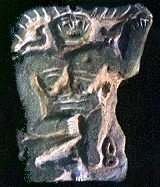
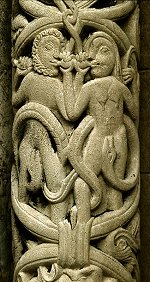
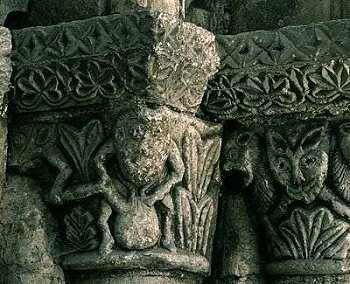
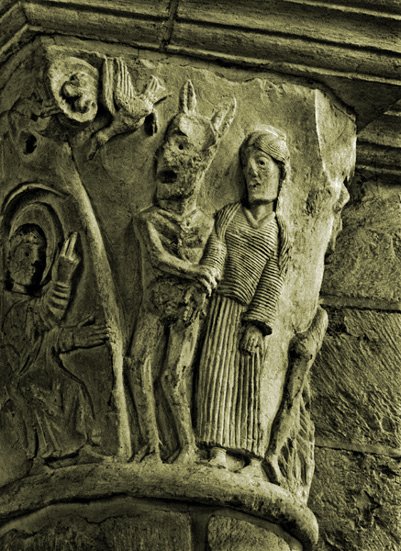
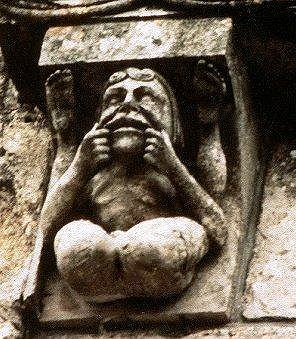
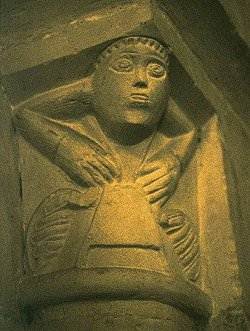
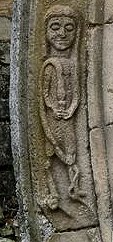
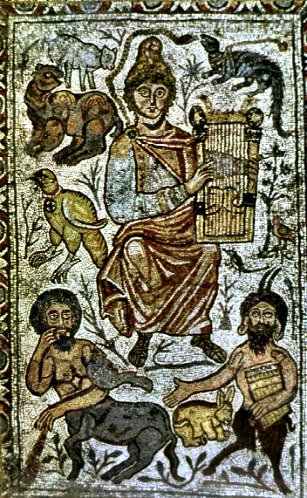
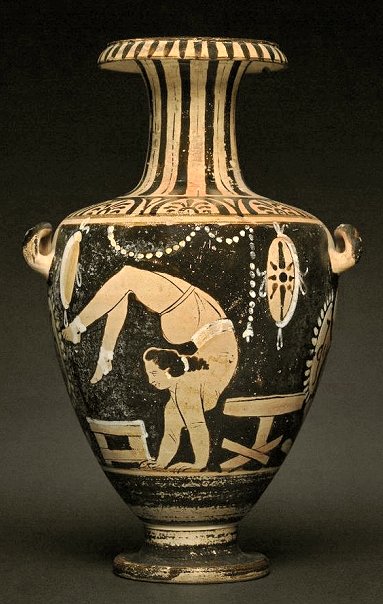
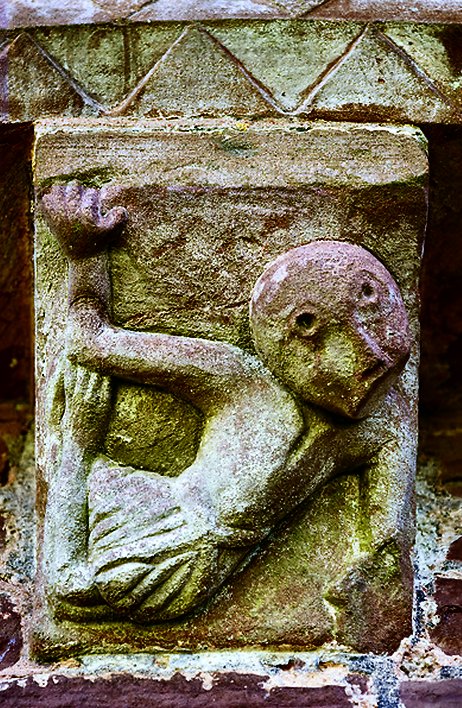
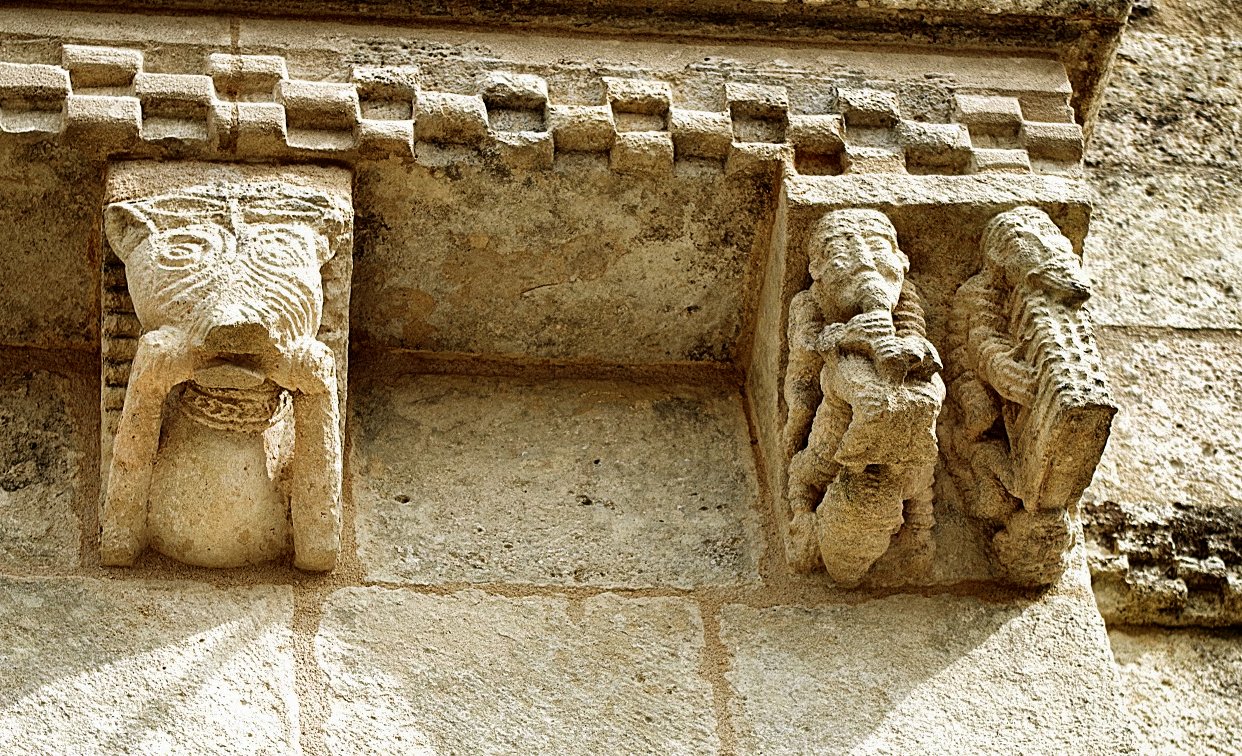
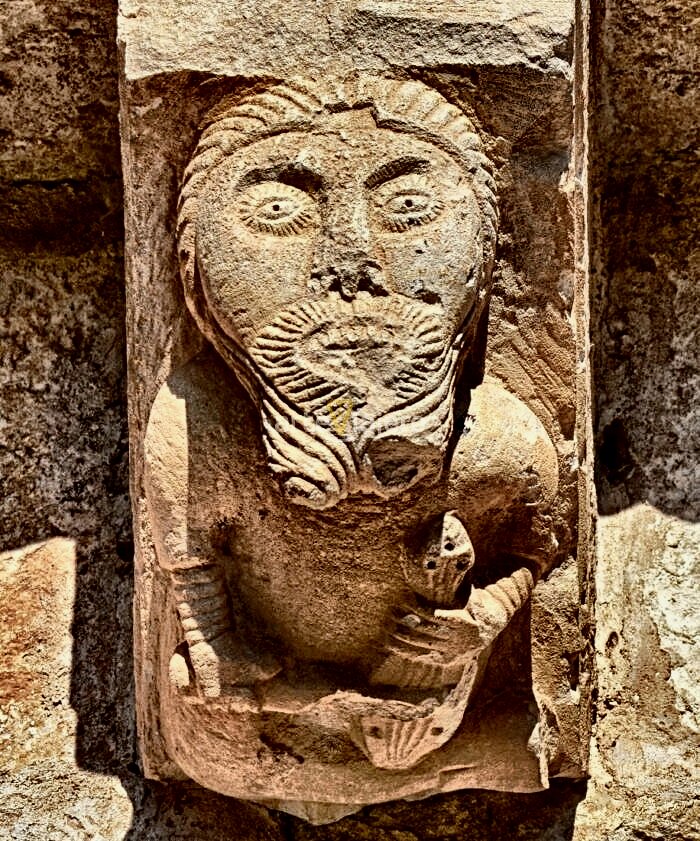
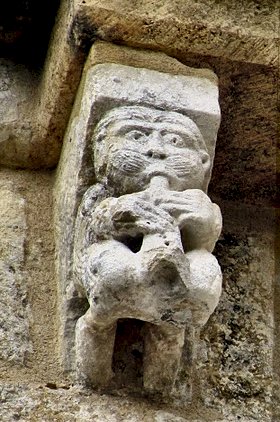 Bewhiskered shawm-player, Cénac (Dordogne)
Bewhiskered shawm-player, Cénac (Dordogne)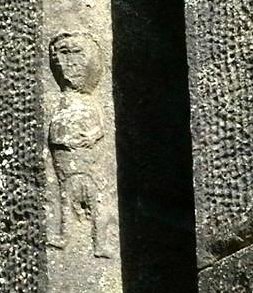
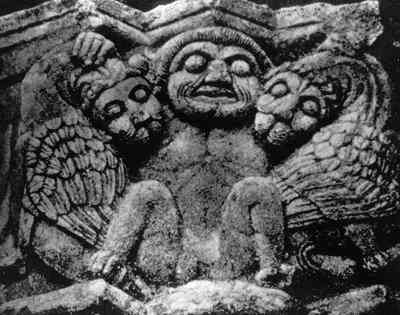
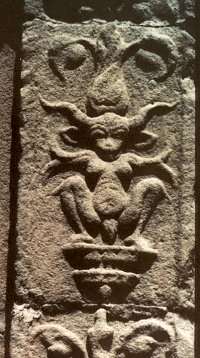
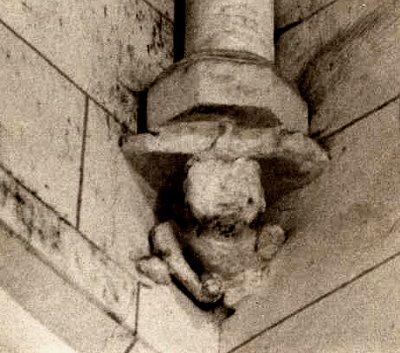
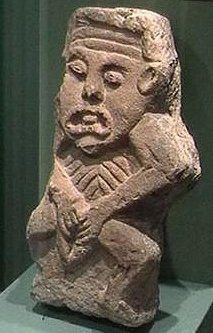
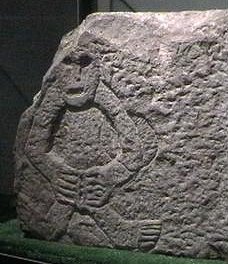
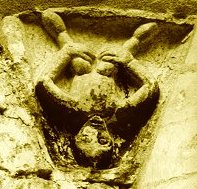 click to enlarge
click to enlarge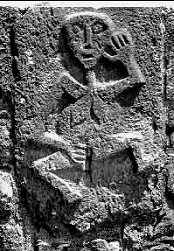
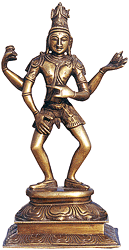
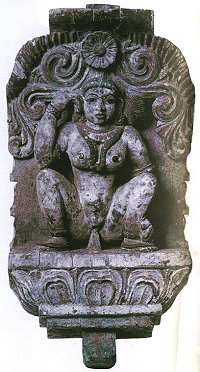
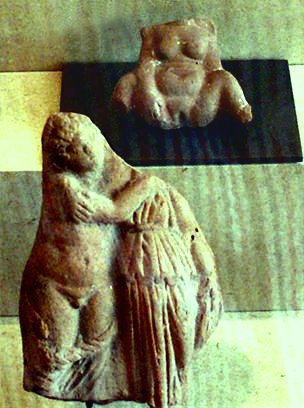 photo by Julianna Lees
photo by Julianna Lees